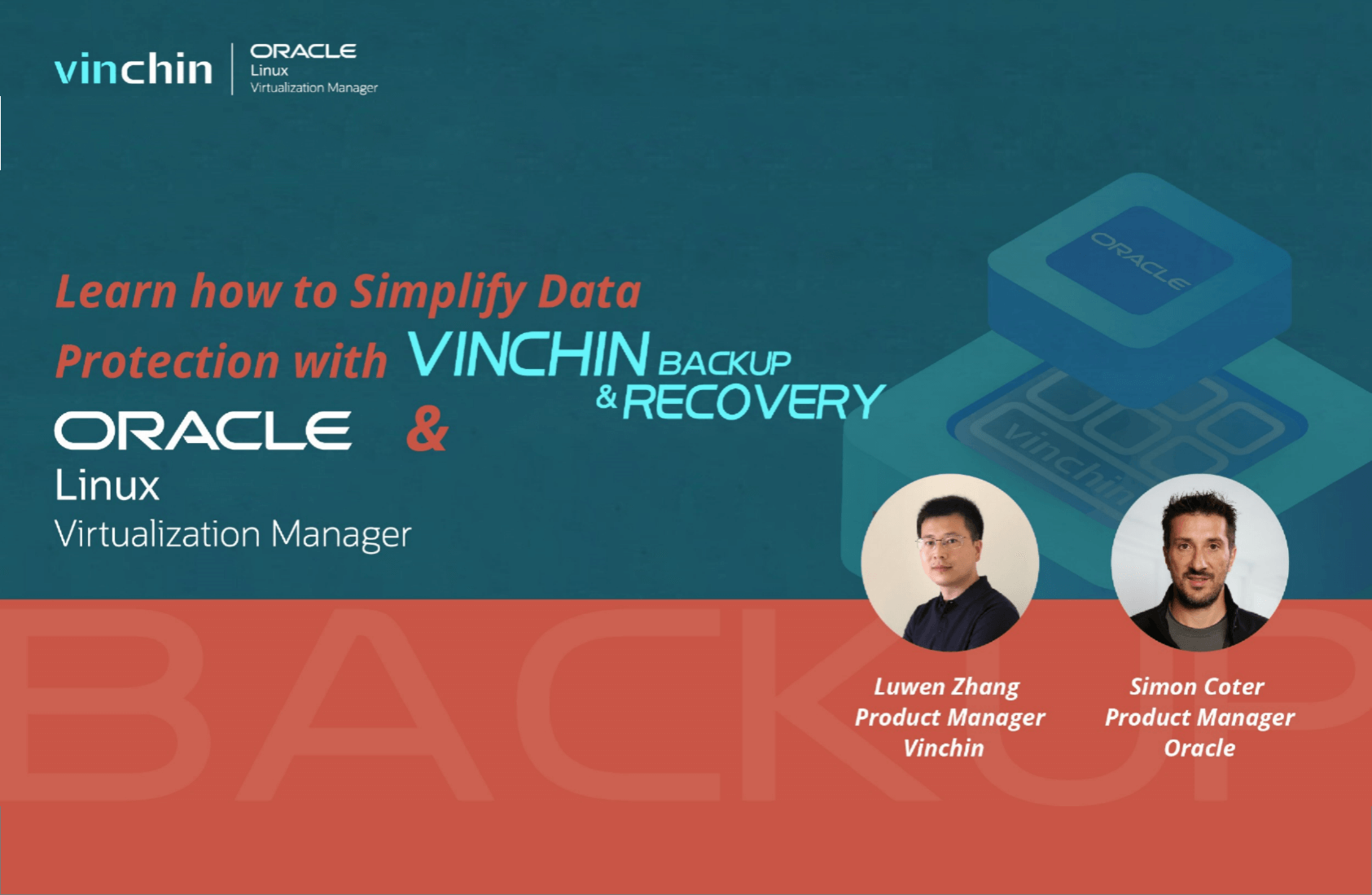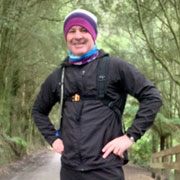-
Introduction to Vinchin Backup & Recovery
-
Key Features
-
Oracle Linux Virtualization Manager Solution Scenarios
-
Oracle Linux Virtualization Manager Backup Strategies
-
Oracle Linux Virtualization Manager Recovery Strategies
On Dec.16, 2020, Vinchin, as one of Oracle's partners and an independent backup software vendor for Oracle Linux KVM and Oracle Linux Virtualization Manager, we are pleased to have a joint webinar with Oracle, and discover more about technical issuers together with you.
In this webinar, we invited Simon Coter, Oracle Linux and Virtualization Product Manager at Oracle, and Luwen Zhang, the Product Manager at Vinchin, to share information about how to simplify data protection with Vinchin Backup & Recovery and Oracle Linux Virtualization Manager.
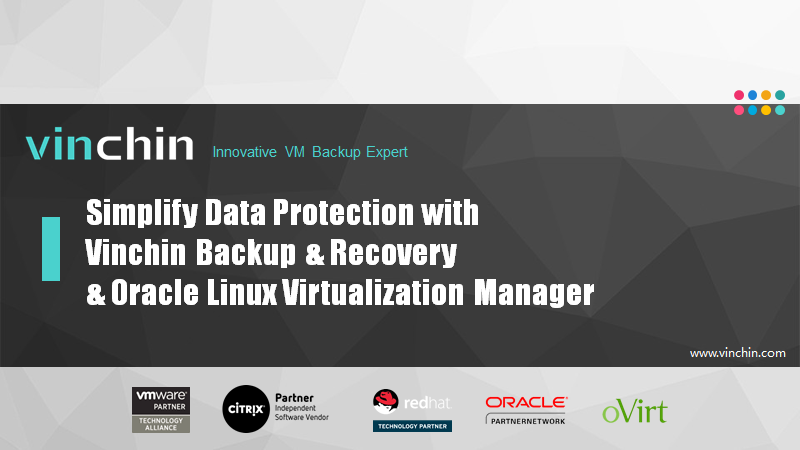
What we talked about in this webinar includes the introduction to Vinchin Backup & Recovery and its key features, also with the backup solution scenarios, backup strategies, and recovery strategies of Oracle Linux Virtualization Manager by Luwen Zhang.
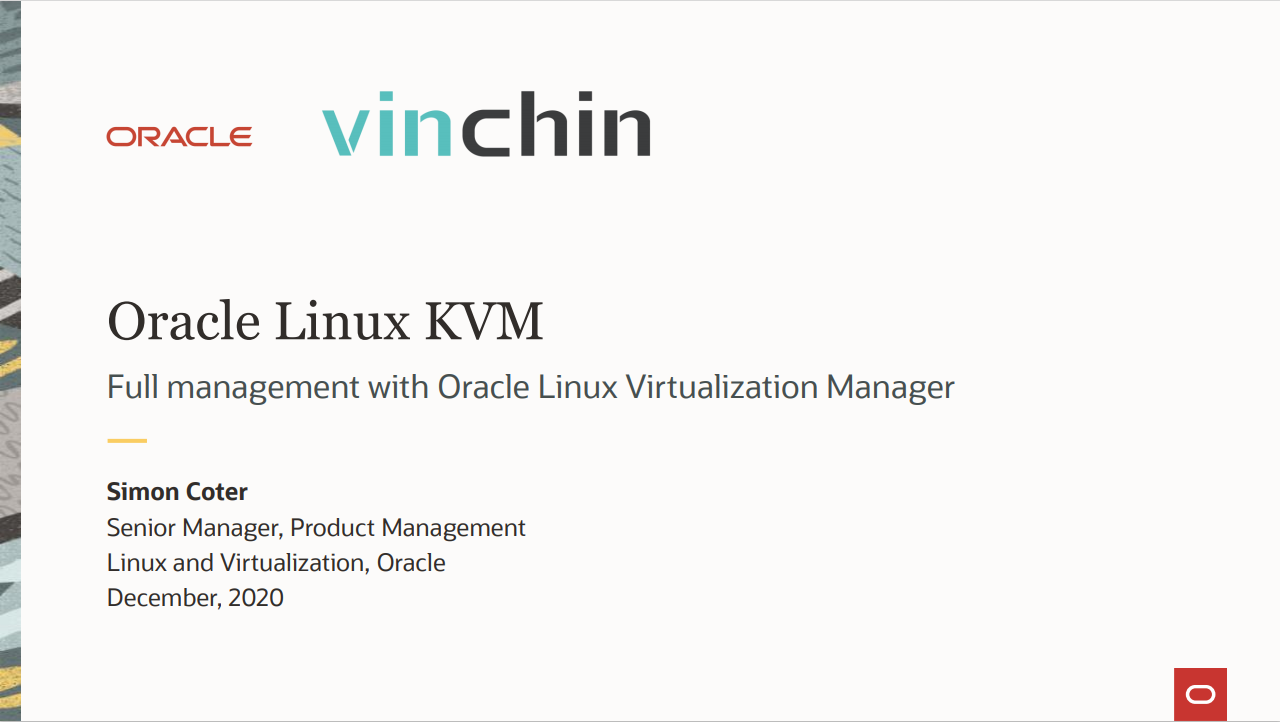
Simon Coter introduced Oracle Linux Virtualization Manager to help you have a better understanding of the product and its simplicity and flexibility of deploying your own virtual infrastructures.
In addition to this, there were also a live Demo show and live Q&A provided for you, there must be something you want to know too!
Let's get a short review of this webinar here!
Introduction to Vinchin Backup & Recovery
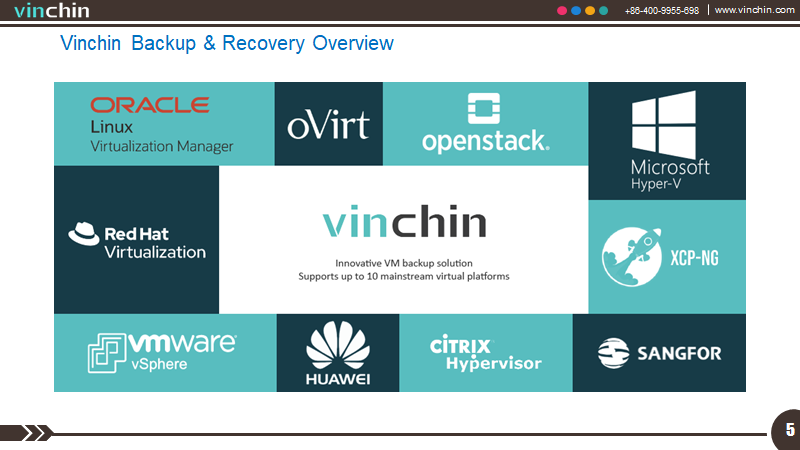
Vinchin Backup & Recovery is an innovative VM backup solution that supports up to 10 mainstream virtual platforms, including Oracle Linux Virtualization Manager, Red Hat Virtualization, oVirt, VMware vSphere, MS Hyper-V, OpenStack, Citrix Hypervisor, XCP-ng, Huawei fusion compute, and Sangfor HCI.
Today we will focus on how Vinchin Backup & Recovery works with Oracle Linux Virtualization Manager.
Key Features
l VM Backup Feature Highlights
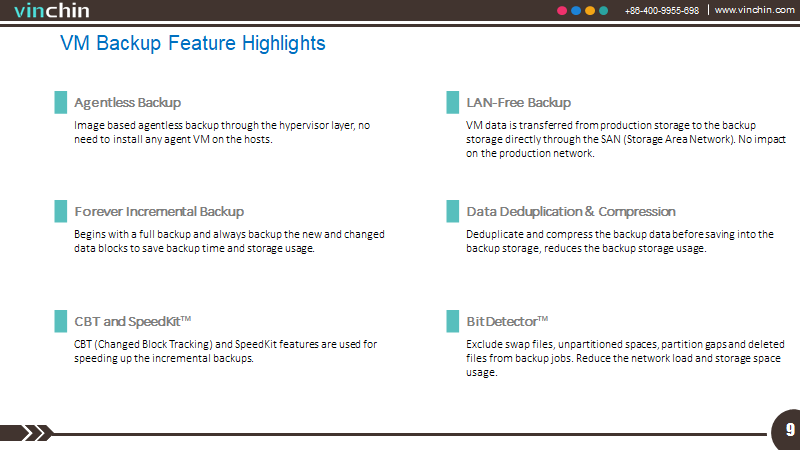
Agentless backup, LAN-Free backup, forever incremental backup, data deduplication, and compression are all supported with Oracle Linux Virtualization Manager.
CBT is under development but Speedkit can work as an alternative to CBT for fast incremental backups.
Besides data deduplication and compression, the bit detector can further reduce the backup data by excluding swap files, unpartitioned spaces, partition gaps, and deleted file blocks from the backup jobs.
l VM Restore Feature Highlights
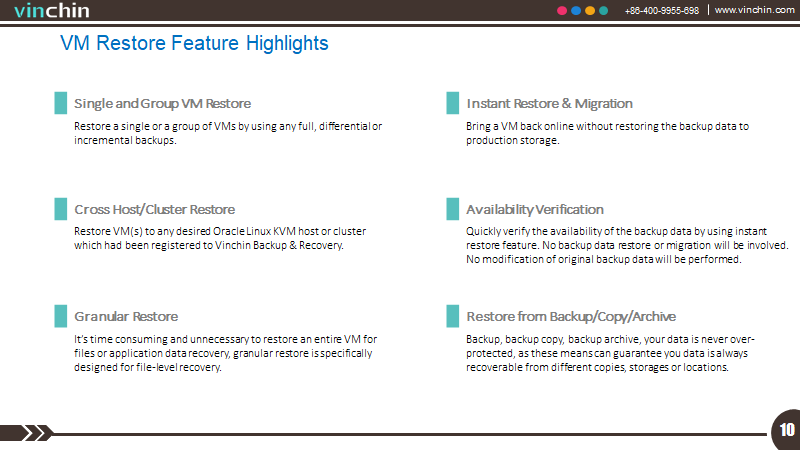
Here are some feature highlights of the VM restore.
The restore of VMs on Oracle Linux Virtualization Manager is also flexible, users can restore a single VM or a group of VMs at a time, and the VMs can be restored to different Oracle Linux KVM host or cluster.
For the VMs with only files is deleted, users can use the granular restore feature to restore the VM from file-level instead of restoring a whole VM.
For some service critical VMs, instant restore feature can help bring up a VM in a minute, and based on this feature, users can quickly verify the backup data availability without restoring the data to the production environment.
And besides the backup data, VMs can also be restored from backup copy data and the archive data. This can guarantee your VMs are always recoverable from different storages or locations even if any disaster occurs.
l Configuration & Management
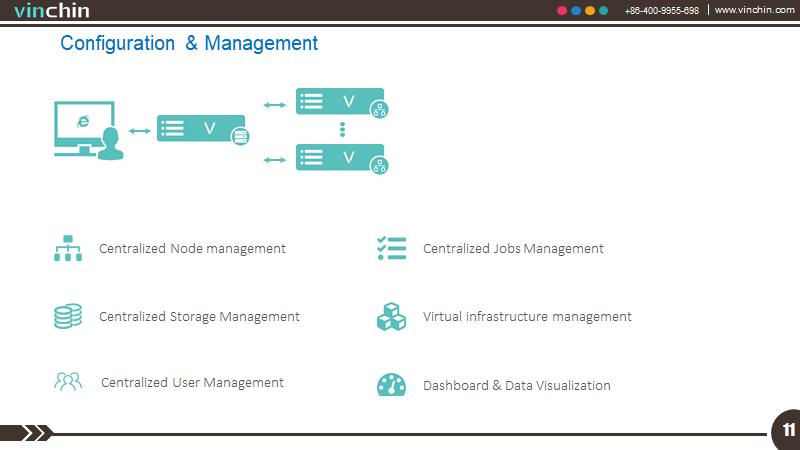
Although Vinchin Backup & Recovery provides lots of VM protection features, the configurations and management are still user-friendly.
You can simply manage your whole backup infrastructure using a unified web interface. Within a single web interface, the backup nodes, jobs, storage, virtual infrastructures, and users can all be managed.
And we also have an intuitive dashboard to monitor the backup infrastructure in real-time.
For those customers who require monitoring the overall status of the backup infrastructure from a big screen, we also have a data visualization module that can display all detailed flow and statistics on a single graphical screen.
Oracle Linux Virtualization Manager Solution Scenarios
l Architecture
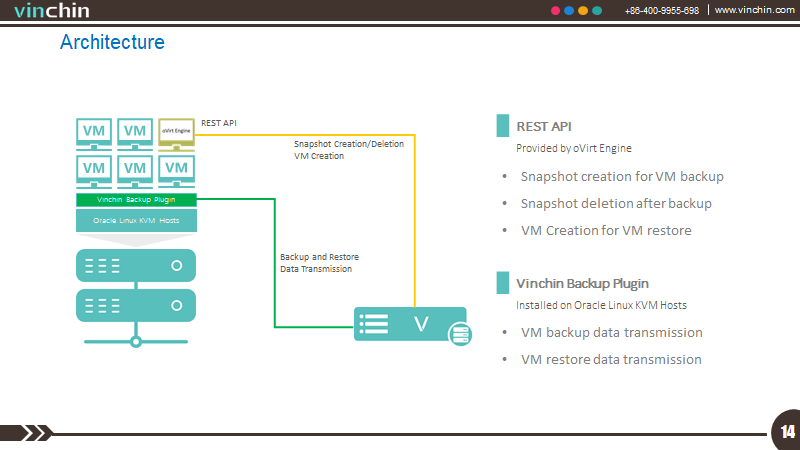
Here's a basic legend explains the working principles of how Vinchin Backup & Recovery back up Oracle Linux Virtualization Manager.
Vinchin Backup & Recovery use the Rest API to connect to the self-hosted oVirt engine on the Oracle Linux KVM host, and snapshot creation for VM backup and snapshot deletion after a backup can be deployed by using the API, and the VM creation for VM restore are all done through the rest API.
A lightweight backup plugin will need to be installed on the Oracle Linux KVM host, it will be mainly used for VM backup and restore data transmission.
The backup plugin is required only when backing up through LAN, if the backup is done over the storage area network, which is also called LAN-Free backup, the backup plugin will not be required.
That's the basic working principle of Vinchin Backup & Recovery works with Oracle Linux Virtualization Manager.
l LAN-Free (SAN) Backup & Recovery
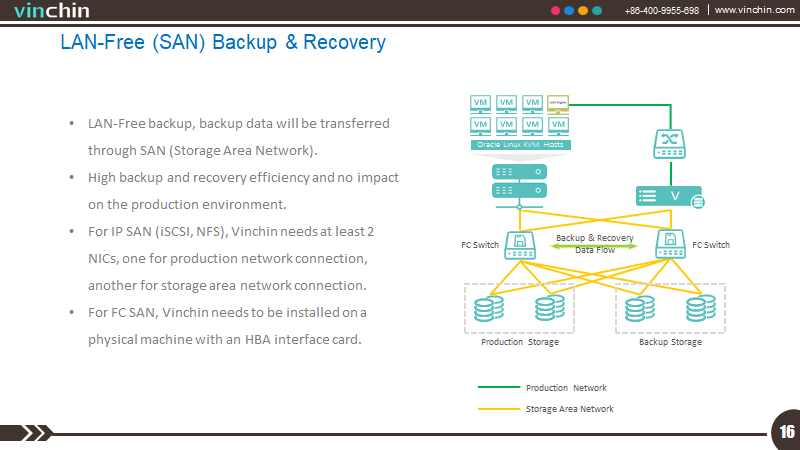
Here's an example of LAN-Free backup & recovery.
As we can see from the diagram, it uses separated networks for production and storage.
Vinchin can use the existing production or management network to connect with oracle Linux virtualization manager -- the oVirt engine. And can use the existing storage area network to transfer the backup and restore data flow.
LAN-free backup & recovery, the data flow will be transferred through the storage area network, high-efficiency backup and recovery can be achieved, yet, it will not impact on the production environment.
For LAN-free backup & recovery, if it’s IP SAN, for example, iSCSI or NFS, Vinchin backup server requires at least 2 network interfaces. If it’s FC SAN, Vinchin backup server needs to be installed on a physical server with an HBA interface card for being able to connect to the FC switch.
l Distributed Deployment
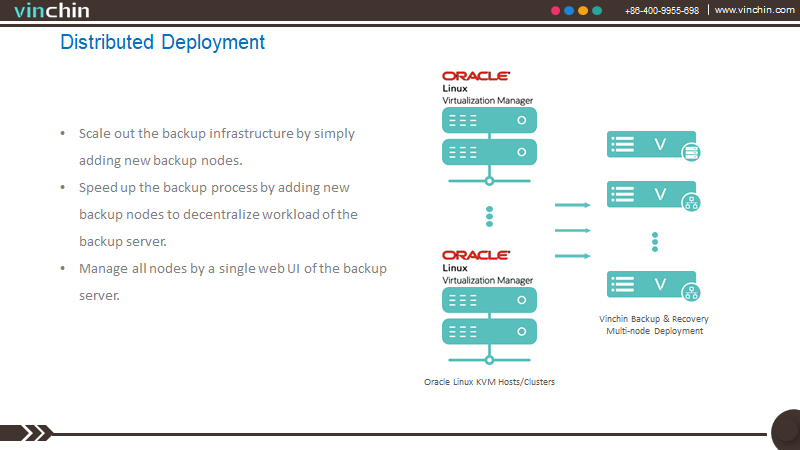
The distributed deployment can be applied with medium to large Oracle Linux Virtualization environments. Multiple Vinchin backup nodes can be deployed with a single Vinchin backup server to speed up the backup process by decentralizing the workload from the backup server to backup nodes.
It also makes the scale-out of the backup infrastructure possible in the future with the growth of your business and the virtual infrastructure.
And adding the backup nodes will neither require extra license fees nor add any complexity of management or maintenance of your backup infrastructure.
l Offsite Copy for DR
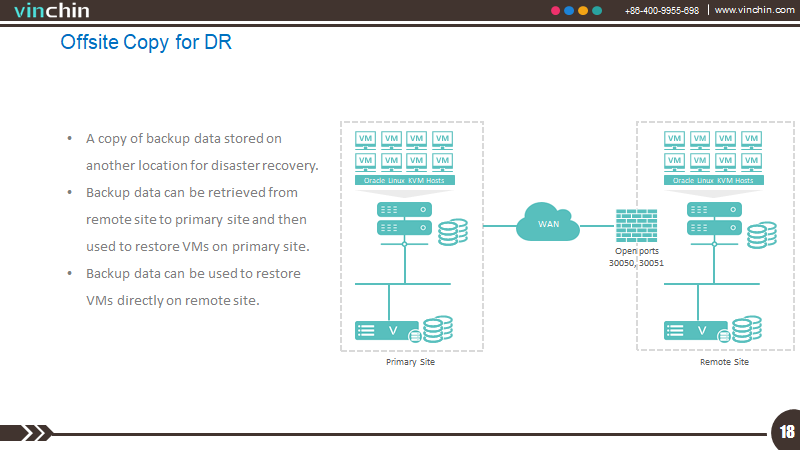
The offsite copy feature can be used for disaster recovery.
Another Vinchin backup server can be deployed on the remote site for storing a copy of your backup data from the primary site to the remote site for DR.
In case any disaster took place and the primary site had been destroyed, you have the option to restore VMs of the primary site to the remote site virtual infrastructure to bring your business back online.
And after the rebuilding of the primary site, you can restore the copy data back to the primary site and then restore the original VMs.
l Backup Archive
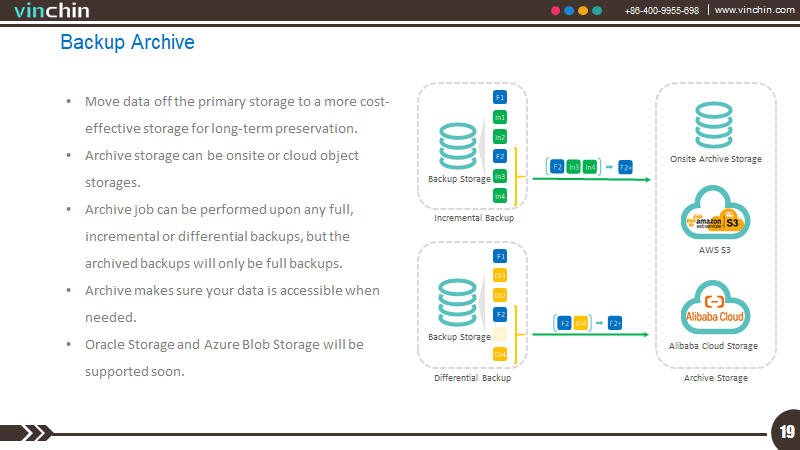
The backup archive can be used to archive your data to more cost-effective storage for long term preservation. The data which is no longer been used or inactive but still has business values can be archived, and it makes sure your data is accessible when needed.
The archive can be performed upon full, incremental, or differential backups, but when archived to the archive storage, only full backups will be saved. So it is different from the backup copy feature, as the backup copy will replicate a copy of the backup data to the onsite or offsite copy storage. But in the archive storages, only full backups will be saved.
This can prevent possible data corruption which leads to a whole backup chain becomes unusable, as it is designed for long-term data preservation. The full backups are independent, and any restore point can be used to restore a VM.
Oracle Linux Virtualization Manager Backup Strategies
l Forever Incremental Backup
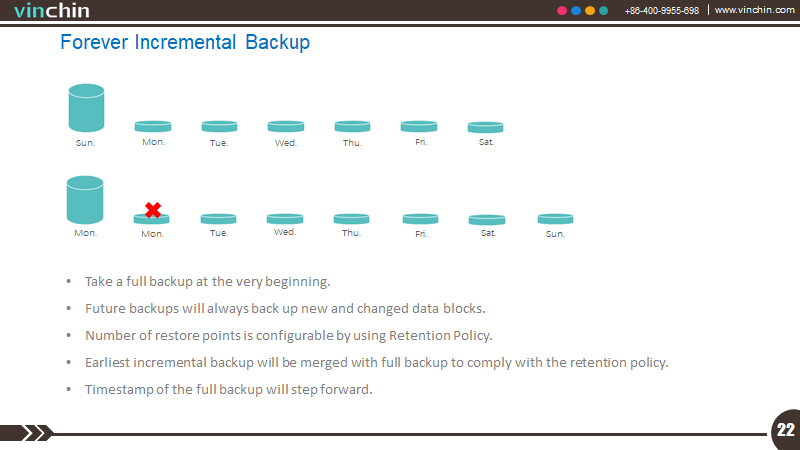
The forever incremental backup strategy.
A full backup will be performed only once at the very beginning, and the future backups will always be incremental, and will always back up the new and changed data blocks.
This can significantly reduce the time it takes for backing up and also reduces the backup storage space usage.
Forever incremental backup is fully supported with the Oracle Linux Virtualization Manager, and the number of restore points is configurable by using a retention policy. As we all know that it is risky to have a long backup chain because all restore points are required to restore the VM to the latest state.
But with the retention policy, this problem is perfectly resolved.
When retention policy is triggered, a merge of restore points will be performed.
As the example showing above, if you’d like to keep 7 restore points when the 8th restore points are generated, the first incremental backup will be merged with the full backup, and the timestamp of the full backup will step forward.
As a result, forever incremental keeps running but you always got 7 restore points.
l Deduplication and Compression
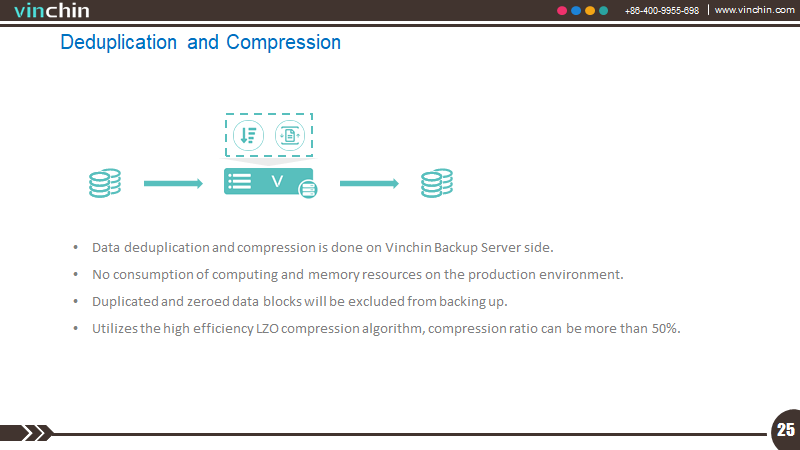
Deduplication and compression can be used to reduce the backup data and save backup storage usage.
The deduplication and compression process are mainly conducted by Vinchin backup server and it will not consume the computing and memory resources on the production environment.
The duplicated and zeroed data blocks will all be excluded from backing up, and the compression is done by using the high-efficiency LZO algorithm, the compression ratio can be more than 50 percent.
l Engine Backup
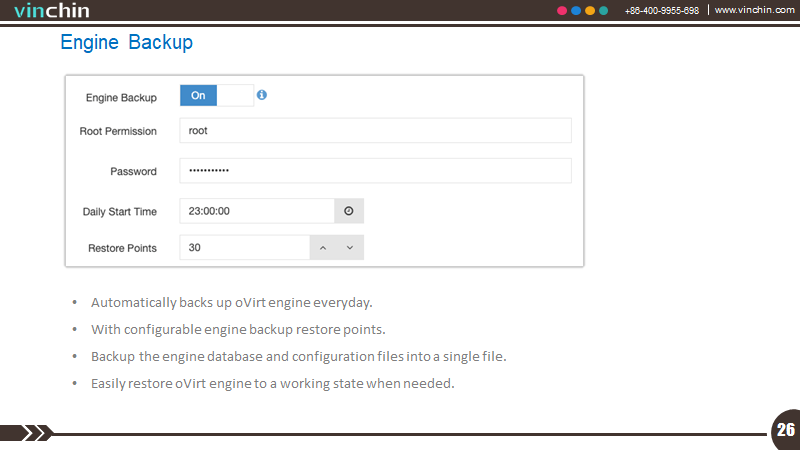
Besides VM backup, Vinchin backup and recovery can also back up the oVirt engine metadata.
If enabled, oVirt engine will be automatically backed up every day, the database and configuration files will be backed up in a single file.
The number of restore points is configurable and you can easily restore oVirt engine to a working state when needed.
Oracle Linux Virtualization Manager Recovery Strategies
l Restore from non-full backups
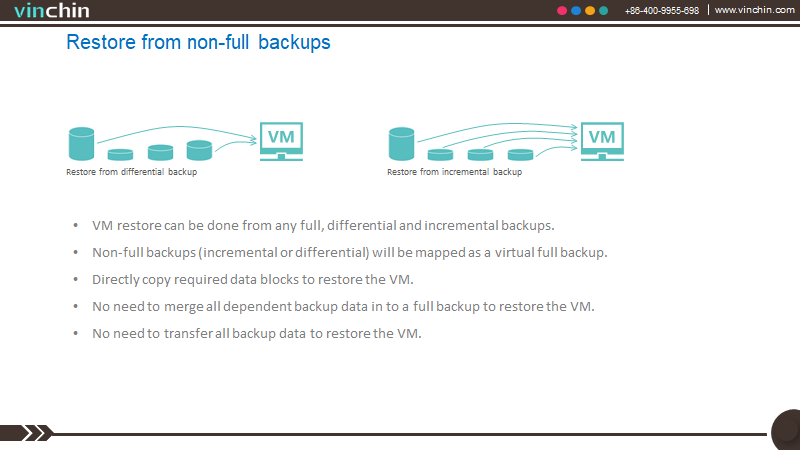
With Vinchin Backup & Recovery, the restoration of VMs can be performed on any full, differential, or incremental backups.
The non-full backups will be mapped virtually as a full backup and then directly copy required data blocks to restore the VMs.
Although when restoring from a differential backup, two restore points will be needed and restoring from an incremental backup, a backup chain will be needed, it does not mean those required restore points all need to be transferred to the production storage to restore the VM.
There's no need to merge the dependent backups into a full backup then perform the restore job, and also there’s no need to transfer all backup data to restore the VM.
So, the working principle of VM restore on Vinchin Backup & Recovery determines there’s no difference between restoration from full backups and non-full backups, the time the two procedures take to restore are the same.
This allows you to freely choose any backup mode which meets your actual requirements.
l Granular Restore
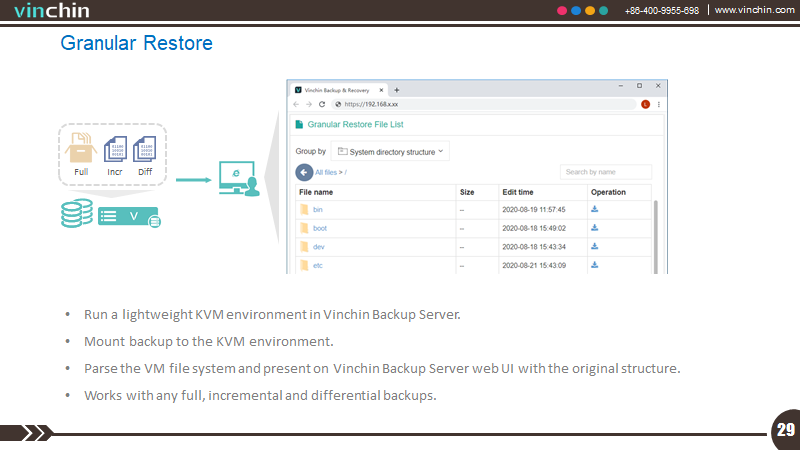
Granular restore is a useful feature to restore your VMs at file level. In most cases, when a VM needs to be restored is because of files or application data being accidentally deleted. It is time-consuming and unnecessary to restore the whole VM for the files or data.
Under such circumstances, the granular restore feature will help.
When performing a granular restore job, it will run a lightweight KVM environment in Vinchin backup server, the backup data will be mounted to the KVM environment, and the file system will be parsed and presented on Vinchin backup server web UI with the original structure, users can then browse and download the required files or folders.
The granular restore feature also works with full, incremental, and differential backups. So you can restore files from any desired time point.
l Instant Restore and Migration
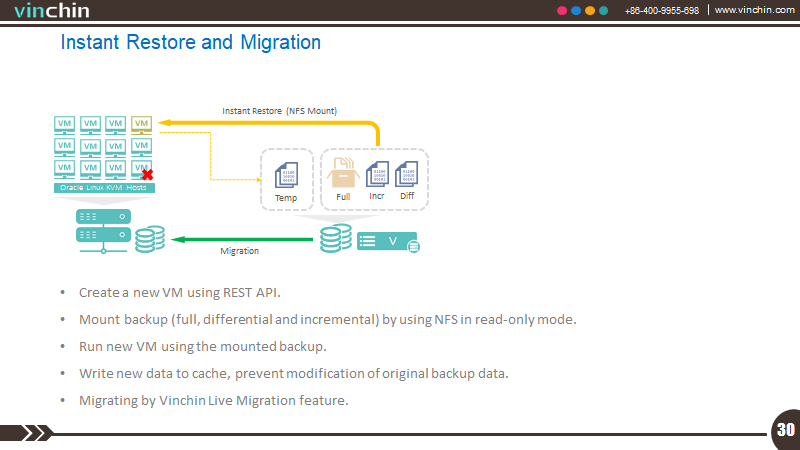
Instant restore is another important VM restore feature that can be used in some emergency situations which enables your business-critical service back up online in a matter of minutes.
It uses the rest API of Oracle Linux Virtualization Manager to create a virtual machine and then mount the backup data to the virtual machine by using NFS protocol.
The newly created virtual machine will only load some required data to start up the operating system and its services so that the instant restore process could be completed in a very short time.
And as the original backup is mounted in read-only mode, so there will be a cache created on the backup storage to write the new data, this can prevent modification to the original backup data.
After the instant restored VM had run through the business hours, you can choose to migrate all the data back to the production storage to complete the whole restore process.
As we know that Oracle Linux Virtualization Manager has a built-in virtual machine migration feature, but for instant restore, it is recommended to use the live migration feature of Vinchin backup server, as the migration will be performed in three stages.
On stage 1, the original backup data will be migrated.
On stage 2, the cache data will be migrated.
On stage 3, the instant restored VM will be powered off if the migrated VM is configured to start up automatically, and then the cache data generated during the powering off of the virtual machine will be migrated.
After these 3 stages of data migration, the consistent state of the virtual machine can be guaranteed.
And by the way, the backup data will be mounted in read-only mode to prevent any modifications to the original backup data, so an instant restore feature can be also used to quickly verify the backup data availability.
We hope you can discover what you want here and also look forward to the next meet. Follow us on Social media to keep tuned for our future webinars! See you next time!
Share on:





